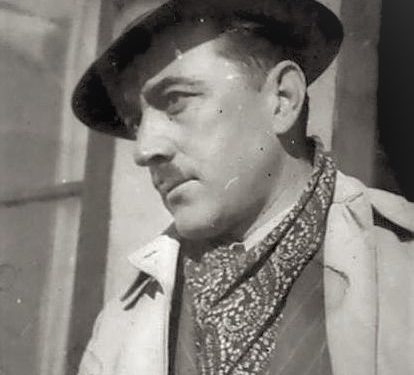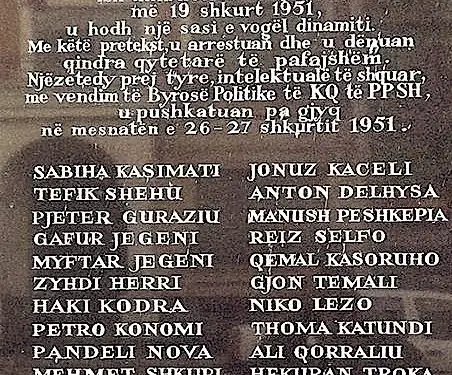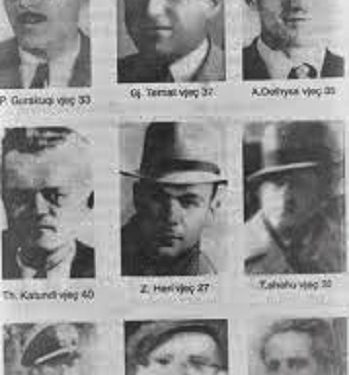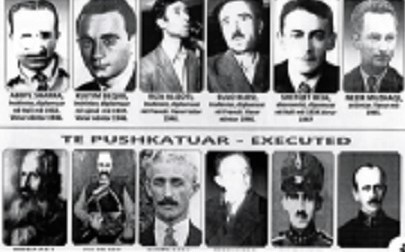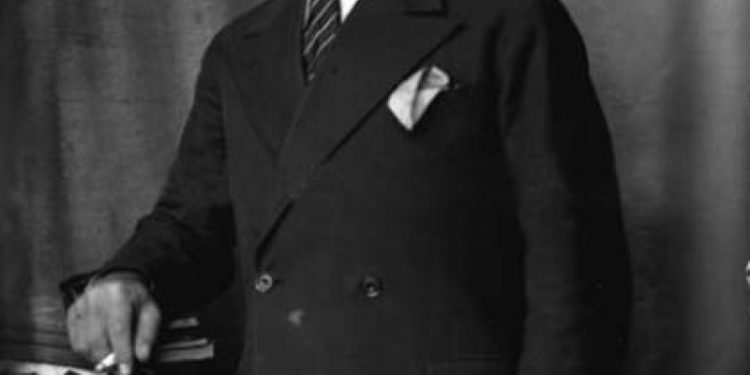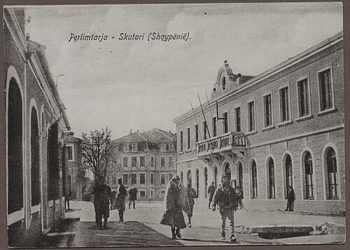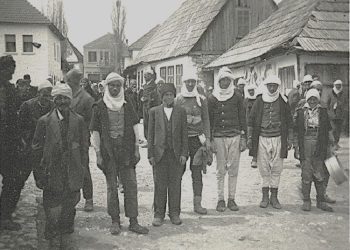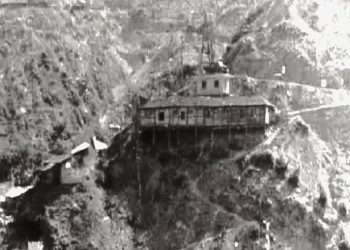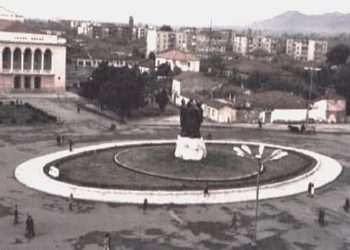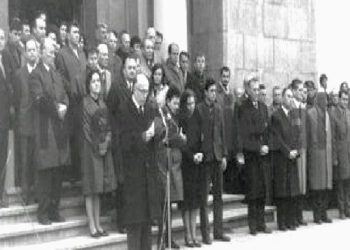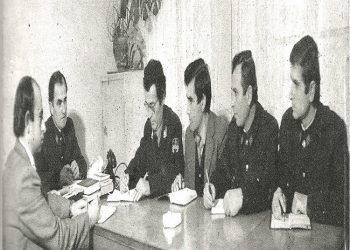From Agim Xh. Dishnicë
Memorie.al / After numerous questions and searches, from 1993, by the Erzen River, under a hill somewhere near the Beshiri Bridge, a pit with human bones was discovered. What was that hole?! The presence of confused women and shocked men indicated that they had not found an Illyrian mound, but a common grave, a macabre grave of 1951. From various signs, they recognized the remains of the bodies of 22 loved ones, shot in at midnight on February 26, 1951, tied to the ground with barbed wire, with a girl between them. Oh horror! Why did they kill them?! It would not be enough to kill many patriots, without trial and with trial, which started as early as November 1944, when the sadist Mehmet Shehu, known for the epithets “white terror”, “red terror”, in 1949, would to say: “We must intensify the fight against the enemies of our power, kill people so that we can cope with the situation”.
The year 1951 was a time when many disappointed citizens hoped that after the break with the Yugoslavs, profound changes would occur. Those who had a radio, listened in vain to Radio London, with the well-known signal: “London is speaking to you”, or Ankara, with “Burasi Ankara”! Meanwhile, at night in the streets and terraces of Tirana, activists of the Democratic Front looked for leaflets thrown by unknown hands, maybe even from the sky, while during the day, paid civilians tracked suspicious passers-by on the sidewalks. Banners appeared on the walls with the strict word “Vigilance!”
In Durrës, when citizens returned home, they found letters on the radio with the shocking note: “Do not open the radio to Italian channels”! On the beach, vacationers were told to stop playing dominoes and go into their dormitories. From the windows, in the twilight, the patrol of the coast guards with guns in their hands could be seen. The fat residents of “Blok”, the leadership on the beach of Durrës near Plepa, had scary dreams at night with sudden attacks from the sea, the air and the mountains! That’s why they woke up scared and in secret meetings, they drew up lists of arrests with names dictated by the main leaders of the Party, some notified by State Security agents.
Suddenly, in the deserted wing of the courtyard of the Soviet Embassy on Durrës street in Tirana, a small amount of dynamite exploded, from which only a few windows were broken. And here, in one night, according to the lists prepared earlier, more than three hundred people were accompanied, among them, were: Sabiha Kasimati, a scholar of the Institute of Sciences, Jonuz Kaceli, from the great Kacel family of Tirana, Ing. . Vasil Nočka, one of the stars of the University of Stuttgart, Prof. Ibrahim Babamusta, well-known personality of Western culture, Gaqo Qano, Doctor of Dental Surgery, returned from his studies in the USA, Gani Strazimiri, prominent construction engineer, Rrok Radovani, professor of Chemistry, Tefik Gabrani, economist, owner of several foreign languages, a patriot returned from Thessaloniki to his homeland for Kosovo and many others.
From the black lists under the dictates of Enver Hoxha and Mehmet Shehu, 22 people, all residents of Tirana, were selected for shooting. Many people were convinced that the “assassination” against the Soviet embassy, and the arrests were carried out by order from above, with the help of the secret service, under the name of State Security, thereby destroying the dreams and hopes of the citizens for the collapse of the communist dictatorship in Albania. . None of the arrested were asked about the sensational incident with the dynamite, but only about the events and biographies of the pre-war period. There were even Russian officials intervening for the release of some of them. It was the time when relations with the Soviet Union were taking the first steps.
Those 22 unfortunates, after being born, raised and educated, walked along the path of life, sometimes with few joys, sometimes shaken by disappointments, or by family dramas, finally a tragic end would await them, by the bloody hand of the communist tyrant Enver Hoxha and the executioner Mehmet Shehu. After the arrest, they were shot at the end of five days, without a prosecutor, without a trial and without any official explanation, at midnight on February 26, 1951, somewhere near the Beshiri Bridge. This action was called legal, according to a cruel decree with six articles, for “terrorist activities” that was drafted belatedly by the head of the Ministry of Interior at that time, Lieutenant-General Mehmet Shehu and was quickly approved by the Presidium of the People’s Assembly and The Political Bureau of the ALP, on February 26, 1951, when everything, without a trial, had ended.
The Minister of Justice was excluded from this disgusting “legal orgy”. February 26 marks a black date for Albanian justice that not only attracts every lawyer in the world, but also the simplest person. A senior officer of that time testifies: “For the shooting of these people, there was no trial and I say this because from the question that was asked by the offices of the Ministry of Interior, they were taken directly to the place of the shooting and were not left time for the judgment of the case…”! So no court hearing took place. Neither the prosecutor nor the judge was heard.
The witnesses and the lawyer were missing. Meanwhile, the victims, tied with wartime barbed wire, were put into a truck. Jonuz Kacel died from torture and was thrown from the window. None of them knew about the decision. In the middle of the night, when the mountain wind howled like a curse, they barbarically shot them all as they were, tied to the ground. When the gunshots stopped, a woman’s painful cry was heard: “What have we done to God”! It was Sabihaja! The bullet had not caught him! Then the soldiers attacked and took his life, shooting him wildly with the butts of their rifles. After a few moments the screaming stopped. Only the roar of the wind and the furious flow of Erzen could be felt…!
A sorrowful moon frowned among the clouds. The slain, as they were, were buried in a common pit. Everything was over. An engine was heard starting. The executioners, having successfully completed their task, disappeared like black hyenas through the night well. The next day, in the houses of Tirana, the villagers of the nearby village knocked in shock on the doors of their friends and, according to an ancient custom, confessed what had happened in the middle of the night. Later, while working to deforest that area, a tractor driver fainted when he saw that the tractor suddenly pulled out a corpse of a woman and was dragging it. The incorrupt body of the martyr Sabiha Kasimati…!
A few days after the execution of the victims, who went to their deaths without knowing why, the court documents were filled in incompletely. When the victims were no longer alive, a late court document reveals an unprecedented act of vandalism, that on February 27, 1951, a body of phantom judges, consisting of three people, without the presence of the prosecutor, had given a decision: “The sentence with death for 22 dead”!? In that shameful document, a signature was again missing. So, the blockmen, the usurpers of Albania, with that murder, threatened the entire freedom-loving people, threatened justice, threatened even God. On this occasion, Enver Hoxha tried to show his great love for his new Soviet friends, and above all to calm down his backward life. Not even the Shakespeare of tragedies could find words to show how, in one night, that terrible massacre was carried out!
After that criminal act, the dictator Enver Hoxha would retaliate with his fist raised: “The internal reaction has crouched like a mouse and was moving, it was black”!
Here were those who lost their lives, most of them at a young age, without any fault, from the cruel shooting on the cold night of February 26, 1951:
– Sabiha Kasimati, 38 years old. Born in Edirne, Turkey, graduated in Italy. Although she was offered a job in the United States of America, this knowledgeable patriotic girl wanted her country, Albania. After returning to his homeland, he worked at the Institute of Sciences alongside prominent scientists in history. How was it possible to sentence to death and massacre an angel like her?! The culprit for this barbaric crime against that rare scholarly girl was the very hand of the envious monster, Enver Hoxha.
– Tefik Shehu, 39 years old, born in Gjakova. Graduated from Zagreb in Economics, Finance and Law. In 1939, he settled and worked in Tirana. After the invasion of Albania, he returned to Gjakovë. There he was arrested by the Serbs, but managed to escape with the help of the Albanian nationalists. In 1945, he was arrested by the Albanian communists in Tirana, but even with the help of the lawyer Koço Dilo, he escaped being shot. On February 26, 1951, no one could protect it from vandals.
– Pjerin Guraziu 45, born in Shkodër. Doctor of Economic Sciences, athlete with international level results. Teacher at the Commercial School of Vlora. Director of Tirana Customs in 1938. After the war, head of finance in the Ministry of Finance and the Ministry of Agriculture. Member of the commission for the organization of athletic competitions in the Balkaniad of 1946. For these skills, he deserved to be shot!
– Jonuz Kaceli, 43 years old. He was born in Tirana, in the great patriotic family of the Kacels, known for services to the benefit of the homeland, in Economy, Culture, Art, etc. Later, according to a witness, for these values, the sadist who was in charge of the Ministry of the Interior, tortured him to death and threw him out of the window. Years passed and the sadist of the “red terror” was sent to his bed, killed.
-Anton Delhysa, 47 years old. He was born in Prizren, a construction specialist; he completed the Fulz Technical School in Tirana with excellent results. He is known as the leader of the works for the construction of the American School in Golem of Kavaja, the Fultz Technical School and the American Embassy in Tirana. After the war, he directed the works for the construction of the Sugar Factory in Maliq of Korça, for the hospital in Gjirokastër, for the Brick Factory in Vorë, etc. For his work, he was also decorated by the Presidium of the People’s Assembly, and finally by shooting…!
-Haki Kodra-, 30 years old. He was born in Dibër e Madhe. After graduating in Economics at the University of Zagreb, he returned to Dibër, where he set up a large business, but was fought by the Serbs, so he left and settled in Tirana in 1940. After the war, he worked in the economic sector, until the black year of the shooting in 1951. –
Gafur Jegeni, 41 years old. He was born in Diber. He was one of the prominent representatives of the Jegens of Dibra. He completed his higher studies at the Military Academy in Italy. From 1935 to 1937, he served as commander of the coastal border in Albania. In the first days of April 1939 in Vlora, with the rank of captain, he performed his duty as a patriot for the defense of the homeland. He was arrested and sentenced to death by the Military Court, then exiled to Ventotene. He was released by the Anglo-Americans in 1943. After that he retired from the army, until February 1951. Epilogue: Instead of the Italian military execution platoon, he was faced with the barbaric execution squad of Albanian soldiers wearing red stars on the forehead.
– Myftar Jegeni, 36 years old. He was born in Diber. Headed the Military Academy in 1937 in Italy. With the rank of captain, on April 7, 1939, he fought in Durrës for the defense of the homeland, then also against the German army. He opposed the Yugoslav massacres against the Serbs, after he was arrested and sent to the hands of the communists in Albania. After the breakdown of relations with Yugoslavia, he worked as an accountant in a construction company in Tirana, until he was arrested in 1951. He could no longer work because, in the middle of the night, he was expected to be shot by the traitor.
-Manush Peshpia, 39 years old, patriotic poet, was born in Vlora. Literary analysts list him alongside Fishta. Poradecin, Koliq, Kutel, etc. This is how the famous writer Vedat Kokona expressed it: “Many of my friends died brokenhearted after decades of suffering and miseries. You, Manush, were one of these lucky ones. No one in this hall and outside of it has known you as I have known you, as my brother, sixty years ago…! I have known many people in my life, I have valued few, I have loved very few as I have loved you. You write poems without pretending to be a poet, not being a poet in verses is not a fault. The fault is not being human. You, Manush, were a human poet”. Even after being shot by the Red Terror at midnight on February 26, this human poet remained alive in verse and light.
-Reiz Selfo, was born in Gjirokastra. He stood out as one of the skilled entrepreneurs in trade and construction. Some of the works, such as the “Selfo” firm in Vlorë, the famous Dragot Bridge over the Vjosë River, the Bênça Bridge in Tepelën, some schools, among them the Gymnasium in Gjirokastër and many others, are clear indicators of his help for the prosperity of Albania, but the hand of the dictator Enver Hoxha, on February 26, 1951, mercilessly snatched the life of this great patriotic businessman.
-Cemal Kasaruho, 49 years old. He was born in Gjirokastra. Economist, master of several foreign languages, In the 1920s-1940s, he worked as a chief inspector at the customs of Saranda, then general director of Monopolies and Taxes at the Ministry of Finance, during the time he participated in the fight against the invaders Italian-German. After the war, he was not accepted to work as an economist in Tirana, but outside of it, in the Rubik mine, finally out of life, but they could not erase him from the nation’s memory.
-Zuhdi Herri, 30 years old. He was born in Tirana. He studied at the Lyceum of Korça and at the Gymnasium of Tirana, and then continued his studies abroad for Law. During the war, he collaborated with the National Liberation Front. After the war, he was the editor-in-chief of the newspaper “Bashkimi” in Tirana. Afterwards, he would be shot without trial, without guilt.
– John Temali, 47 years old. He was born in Shkodër. In the 40s he studied pharmacy at the University of Florence. From 1946 to February 1951, pharmacist at Tirana Hospital. This man, dedicated to the humanitarian service of Medicine, had to be killed as a “terrorist”, without trial and guilt.
– Petro Konomi, 30 years old. He was born in Cairo. He completed his higher studies in Turkey at “Robert College”, then at the Military Academy in Italy. During the war, he supported the National Liberation Front. After the war, he was appointed to the Albanian Telegraphic Agency. Even this “angel” employee had to be tied with wire to be killed.
– Niko Lezo, 50 years old. He was born in Delvina. Chemist. Master of several foreign languages. He graduated from the University of Toulouse in France in 1921. In 1923, he set up the first chemical laboratory in Tirana. In the same year, he was elected deputy of Delvina. In 1940, he was arrested and exiled to the island of Ventotene in Italy. After the war, he worked again as a chemist in the laboratory he had set up himself, now under the Ministry of Health. This unforgettable founder of the first Albanian laboratory had to be shot mercilessly!
– Pandeli Nova, 59 years old. He was born in Opar in Kora, in a rich family Economist. Master of several foreign languages. Until 1944, he was engaged in trade and at the same time helped the National Liberation Front. After the war, he worked in a Czech-Albanian trading company. This, the parent of a partisan boy, at midnight on February 26, 1951, would hear for the last time the harsh voice of the partisan commander: “Fire”!
-Thoma Katundi- The “oldest” in age, 64 years old! He was born in the village of Katund in Korça. Former homeland in the USA. Burning with longing, he returned to his homeland and worked honestly. Raised by American democratic ideas, despising any tyranny, he lost his life on February 26, 1951. His fault was not only the love of freedom, but also the longing for the homeland.
– Mehmet Skopje, 58 years old. He was born in Skopje and lived in Tirana. Former owner with high school education and clerical profession. He was suspected of being an “agent” of the French Legation and of carrying out terrorist activities. So, the “concrete evidence” for the death sentence without a trial was served by a trick called doubt!
-Ali Qorraliu, 61 years old. He was born in Tirana in a very rich autochthonous family. He completed his higher studies at the Thessaloniki Law College, where he graduated as a lawyer. During the war, he had supported the “National Front”, so he was imprisoned by the newly established communist regime. However, after his release from prison, he did not take any action against the regime. Without having any heir, he was arrested as a “terrorist” and was shot mercilessly, without trial. He left only the memory of a man, knowledgeable and rich. When the grave was discovered, it was noticed that before the shooting, they had pulled out his gold teeth!
-Fadil Dizdari, originally from Shkodra, was born in Kavajë. At the time of Zog, he worked as a prefecture secretary. In love with books and his fiancee, he opened a bookstore in the center of Tirana. He was arrested and shot without trial, suspected of being a “terrorist” or “enemy of the Government.” Popular”! In fact, his fault was his generosity, as he sold almost for free the world masterpieces, so-called “yellow”, of famous authors, such as: Victor Hugo, Aleksandër Dyma, Frederik Shiler, etc. Only the engagement ring that was found in the pit survived, as if to testify to the secret and barbaric crime, in the middle of the night!
– Hekuran Troka, 32 years old. He was born in Kuçovo and lived in Tirana, with a trade profession. In the blacklist for this handsome guy, it is noted: “suspicious trader speculator”, “agent of foreign services” and “terrorist”. He was shot as a suspect, but without a trial. The family was exiled and worked in hard labor for a living. This is how they were punished for lack of evidence and those who were suspected were killed at night.
-Lluka Rashkovic, 51 years old. He was born in Montenegro. He came to Albania with his family during the Kingdom of Zogu. In different periods of time, he was involved in the transport of passengers, in Albania and the Balkans, outside of any political current. For all this clean life and honest work in the service of our country, he was arrested and shot without trial.
About the pit abandoned in the cold darkness 60 years ago, by the executioners of the century, the bones spoke, the stones also spoke, the discovered archives also spoke, such as the pit of the murdered, the memory of honest people, of sisters, of brotherhoods also spoke. , of nephews, citizens and honest villagers. They spoke loudly for the world to hear and for the youth to find out, albeit belatedly, who the Socialist or Communist People’s Republic of Enver Hoxha and Mehmet Shehu really was, a “lighting beacon” in Europe, or a prison common grave of Albanians?! Memorie.al




